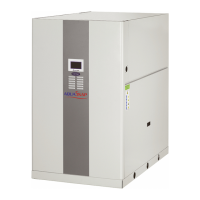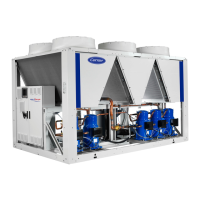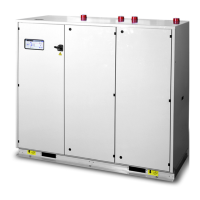69
21 - AQUASNAP MAINTENANCE PROGRAM
All maintenance operations must be carried out by technicians
who have been trained on manufacturer products, observing all
quality and safety standards.
21.1 - Maintenance schedule
Regular maintenance is indispensable to optimise equipment
operating life and reliability. Maintenance operations must be
carried out in accordance with the schedules below:
Service Frequency
A
Weekly
B
Monthly
C
Annually
D
Special cases
If the equipment does not operate normally during maintenance
operations, refer to the chapter on diagnostics and breakdowns
of the TouchPilot Junior Controls manual).
According to the selected maintenance type, the unit shall rise an
alert (13004, Partial):
- 15 days before the estimated checking date if check
< 3 months
- 21 days before the estimated checking date if check
> 3 months.
IMPORTANT: Before each equipment maintenance operation
please ensure that:
- The unit is in the OFF position
- It is impossible for the unit to restart automatically during
maintenance.
21.2 - Description of the maintenance
operations
The equipment is supplied with polyolester oil (POE). Use only
the manufacturer-approved oil. On request the manufacturer can
carry out an oil analysis of your installation.
Service A
Full-load operating test
Verify the following values:
- Compressor high-pressure side discharge pressure
- Compressor low-pressure side suction pressure
- Charge visible in the sight glass
- Temperature difference between the heat exchanger water
entering and leaving temperature.
Verify the alarm status
Service B
The manufacturer out the operations listed under Service A.
Refrigerant circuit
Full-load operating test. In addition to the operations described
under Service A, check the following values:
- Compressor discharge pressure
- Compressor oil level
- Actual liquid subcooling
- Overheating at the expansion device
Verify the charge status by checking the colour indicator of the
sight glass. If the colour has turned to yellow, change the charge
and replace the lter drier cartridges after carrying out a leak test
of the circuit.
Electrical checks
- Check the tightening of the electric connections, contactors,
disconnect switch and transformer.
- Check the phase direction upstream of the unit and in the
customer’s electrical data table.
- Check the status of the contactors and fuses.
- Carry out a quick test (refer to the TouchPilot Junior Controls
manual).
Mechanical checks
- Verify the correct operation of the evaporator and condenser
pumps with the Quick Test function.
- Verify the correct operation of cooling fans, speed converter
and condensing pumps.
Water circuit checks
- Check the leak-tightness of the circuit.
Service C
Carry out the operations listed under Service B.
Refrigerant circuit
- Check the leak-tightness of the circuit and ensure that there
is no piping damage.
- Carry out an oil contamination test. If acid, water or metallic
particles are present, replace the oil in the circuit.
- Verify the tightening of the thermostatic mechanism of the
expansion device.
- Full-load operating test. In addition to the checks carried out
under Service B, validate the value between leaving water
and the saturated evaporating temperature.
- Check the operation of the high-pressure switch(es). Replace
them if there is a fault.
- Check the fouling of the filter drier (by checking the
temperature difference in the copper piping). Replace it if
necessary.
Electrical checks
- Check the status and insulation of the electrical cables.
- Check the phase/earth insulation of the compressors and
pumps.
- Check the compressor and pump winding status.
Mechanical checks
- Check that no water has penetrated into the control box.
- Clean the lter of the air inlet grille and if necessary replace
the lter.
Water circuit checks
- Clean the water lter.
- Purge the circuit with air.
- Verify the correct operation of the water ow switch.
- Check the status of the thermal piping insulation.
- Check the water flow by checking the heat exchanger
pressure difference (using a pressure gauge).
- Check the concentration of the anti-freeze protection solution
(ethylene glycol or polyethylene glycol).
- Check the heat transfer uid status or the water quality.
- Check the steel pipe corrosion.

